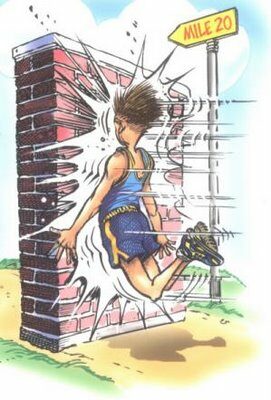In our third and final part of the the mental fitness series, we look at some specific mental toughness strategies you can use in training and racing. 
Part one looked the role of our motivations, while part two considered the ways in which our thoughts influence our behaviors. In this part, we look at how our motivations and thoughts connect with our feelings about training and racing, and how we can incorporate specific strategies to improve our mental fitness.
One feeling that keeps us coming back for more is a runner’s high or a flow experience, which is a “’subjective state that people report when they are completely involved in something to the point of forgetting time, fatigue, and everything else but the activity itself’” (Schuler & Brunner, 2009). In their studies of marathon runners, Schuler and Brunner found that this flow experience can predict motivations to run in the future and improve pre-race training through enhanced focus and compliance with the training plan. This improved motivation and focus translates to better race day performances.
While a flow experience is positive, it is also fleeting and intermittent. Let’s face it: the runner’s high doesn’t appear on command, no matter how much we wish it would.
Most days, training is hard work. What pushes us through this hard work? Our mind.
Associative & Dissociative Strategies
The research has identified two broad attention strategies that athletes can use to cope with intense or hard efforts: associative and dissociative. Raglin (2007) explains associative strategies as a method of “paying close attention to physiological sensations of exertion such as muscular pain, muscular fatigue, hydration, body temperature and respiration” (p. 406). As such, athletes who use this particular strategy are more closely monitoring their rate of perceived exertion, thereby aiding the processes associated with the central governor model. Raglin reports that a majority of research finds elite-level athletes using more associative strategies during racing.
In contrast, dissociative strategies use “various psychological routines to intentionally distract themselves from the discomfort of physical exertion… [which] often involved unusual methods such as conducting complicated mathematical calculations, mentally designing and building a house, and reliving past experiences, each done to diminish the painful sensations of the marathon” (p. 406). Dissociative strategies are correlated with lower finish times, and are used by nonelite athletes more so than elite athletes (Hutchinson & Tenenbaum, 2007). Furthermore, dissociative strategies have also been correlated with higher risks of injury, higher reports of hitting the wall, and performances that are below expectations (Buman, Brewer, Cornelius, Van Raalte, Petitpas, 2008).
However, Hutchinson and Tenenbaum (2007) suggest that dissociative strategies may have a role to play in lower intensity training efforts, where the need to moderate thoughts of RPE is not as great as it is with more intense training or racing. These authors found that when task intensity was high, the athlete’s focus was mostly associative, and attentive to rate of perceived exertion. For lower intensity tasks, dissociative strategies became more dominant.
 Associative and dissociative strategies have been found as key coping mechanisms among endurance athletes who report “hitting the wall” (Buman, Omli, Giacobbi & Brewer, 2008). While the physiological reasons for hitting the wall come from a reduction in glycogen stores, the characteristics of hitting the wall also include affective, behavioral, cognitive, and motivational dimensions. Our thoughts about expectations of hitting the wall, as well as what we think once we start experiencing the physiological symptoms are an incredibly important component to managing these sensations.
Associative and dissociative strategies have been found as key coping mechanisms among endurance athletes who report “hitting the wall” (Buman, Omli, Giacobbi & Brewer, 2008). While the physiological reasons for hitting the wall come from a reduction in glycogen stores, the characteristics of hitting the wall also include affective, behavioral, cognitive, and motivational dimensions. Our thoughts about expectations of hitting the wall, as well as what we think once we start experiencing the physiological symptoms are an incredibly important component to managing these sensations.
Cue the central governor.
In addition to the use of associative or dissociative strategies, Buman, Omli, Giacobbi & Brewer (2008) found that athletes engaged in other cognitive strategies, including mental reframing, race goal renegotiation, relaxation, self talk, visualization and willpower. Those who reported using willpower frequently relied upon this strategy without combining it with any others. Moreover, the authors suggest, “The use of willpower indicates that recreational runners perceive control over HTW [hitting the wall] and that overcoming (or at least sustaining) the effects of HTW are possible” (p. 296).
A study by Buman, Brewer, Cornelius, Van Raalte, Petitpas (2008) further suggests that expecting to hit the wall may increase your odds of experiencing those sensations by a factor of three. They explain this phenomenon as a self-fulfilling prophecy. “It is possible that participants’ expectations about how they would respond to marathon stresses influenced the way they interpreted and experienced the symptoms they encountered during the marathon” (p. 188). Having hit the wall in a previous marathon further increased the odds of experiencing the sensations by 2.5 times.
Taken as a whole, these studies make it clear that training our bodies is only one part of the plan for endurance sport. We must also train our brains, examining our motivations, our coping strategies and our expectations if we hope to achieve a successful performance. Based on the research, we conclude that there is some scientific truth to the adage, “What the mind believes the body achieves” (anonymous).
Have you ever hit the wall? What strategies do you use to handle the hard work of training and racing?
*~*~*~*~*~*~*~*~*~*~*~*~*~*~*~*~
References
Buman, M.P., Brewer, B.W., Cornelius, A.E. (2009). A discrete-time hazard model of hitting the wall in recreational marathon runners. Psychological of Sport and Exercise, 10, 662-666.
Buman, M.P., Brewer, B.W., Cornelius, A.E., Van Raalte, J.L., Petitpas, A.J. (2008). Hitting the wall in the marathon: Phenomenological characteristics and associations with expectancy, gender, and running history. Psychology of Sport and Exercise, 9, 177-190.
Buman, M.P., Omli, J.W., Giacobbi, P.R., Brewer, B.W. (2008). Experiences and coping responses of “hitting the wall” for recreational marathon runners. Journal of Applied Sport Psychology, 20, 282-300.
Hutchinson, J.C., & Tenenbaum, G. (2007). Attention focus during physical effort: The mediating role of task intensity. Psychology of Sport and Exercise, 8, 233-245.
Raglin, J.S. (2007). The Psychology of the Marathoner: Of one mind and many. Sports Medicine, 4-5, 404-407.
Schuler, J., Brunner, S. (2009). The rewarding effect of flow experience on performance in a marathon race. Psychology of Sport & Exercise, 10, 168-174.
